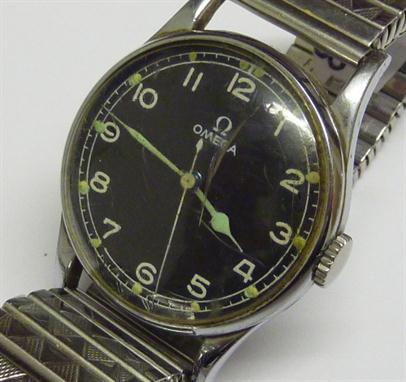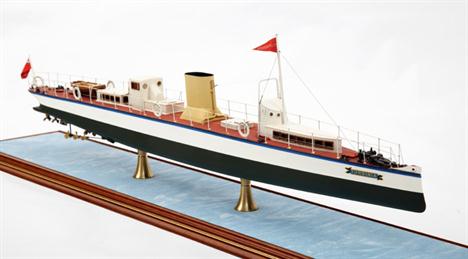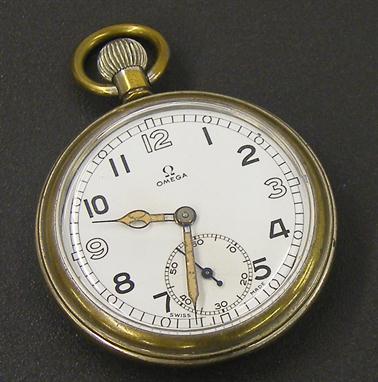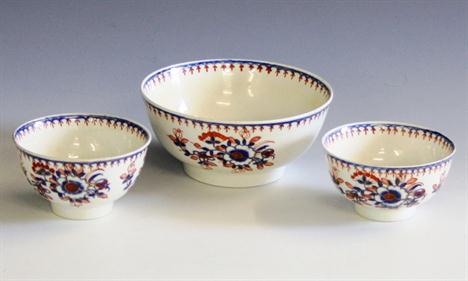We found 32197 price guide item(s) matching your search
There are 32197 lots that match your search criteria. Subscribe now to get instant access to the full price guide service.
Click here to subscribe- List
- Grid
-
32197 item(s)/page
A WWII Casualty Medal Group, awarded to Chief Engineer Herbert Stanley Qualtrough of the S.S. Rushen Castle, Douglas, he died on 1st February 1944 aged 53, his grave reference is Block M.Q. grave 281 at Douglas Cemetery, Isle of Man, the Medal Group comprises British War medal, Mercantile Marine service medal, 1939-45 star, Atlantic star, 1939-45 medal, also a British War medal awarded to 19064/3 Driver F A Klatovsky of the Royal Artillery, three whistles, one Metropolitan, ARP, and another with a military broad arrow mark, also a Royal Artillery Christmas card and leather bound life preserver, this lot is accompanied by some research
Early 20th Century Cream Linen Livery Coat with blue linen collar and cuffs, double breasted with plated buttons, bearing a crest depicting a boar standing passant, pierced through the shoulder with an arrow. According to Fairburns Book of Crests this crest represents three families; George Pollock of Lanarkshire, Rev Bertram Pollock of Berkshire and the Annat Family of Scotland
TWO LARGE 19TH-CENTURY ROYAL NAVY LIGNUM VITÆ FIDS, with pinned steel cuffs to top, the larger one impressed with the Government broad arrow mark and numbered ‘RLT 87 [MARK] 9104596’ -- 24in. (61cm.) long; together with a souvenir pipe rack from H.M.S. Victory; and a plated tot cup inscribed for the launch of H.M.S. Colossus in 1909, (4)
A FINE AND RARE SILVER-CASED KEYLESS DECK WATCH BY VACHERON & CONSTANTIN, GENEVE, PRODUCED FOR THE BRITISH HYDROGRAPHIC SURVEY, 1940S, with 2in. matt silvered dial signed as per title with Arabic numerals and blued-steel spade hands with sweep seconds, 21 jewels, straight line lever escapement with Guillaume balance and special alloy Breguet balance spring, swan-neck micrometer, movement counter-signed and numbered ‘454898’, contained in fully-marked silver case numbered ‘286295’ stamped on reverse ‘H.S. 2 54898’ with Government broad arrow mark (suspension fob missing) -- 2½in. (6.5cm.) diameter
A LATE 18TH/EARLY 19TH-CENTURY MARINE INCLINOMETER, ATTRIBUTED TO JESSE RAMSDEN, the lacquered-brass pendulum indicator with reciprocating upper action mounted on a bedplate engraved with two 30º scales and broad arrow marks, contained within an inverted glazed keystone case for bulkhead mounting -- 22in. (56cm.) high, A near-identical example of this instrument signed by Ramsden was sold at Christie’s, South Kensington, 17 November 2004, Sale 9969, lot 210.
A LATE 18TH-CENTURY BRASS THEODOLITE BY THOMAS JONES, LONDON, signed on the base plate Thomas Jones, Charing Cross, London, and impressed with the Government broad arrow mark between ‘BO’, numbered 2176, silvered compass, quadrant with telescope and level over (missing parts, old wear) -- 10 x 11in. (25.5 x 28cm.)
A FINE AND WELL-PRESENTED 1:48 SCALE STATIC DISPLAY MODEL OF THE WORLD’S FIRST TURBINE-POWERED CRAFT TURBINIA DESIGNED BY SIR CHARLES PARSONS IN 1894, modelled by John R. Haynes with bespoke pre-formed hull, painted deck with superstructure and fittings as appropriate and including anchor, winch, glazed wheel house with steering wires to aft rudder shoe, deck rails with named life buoys, raked buff-coloured funnel, engine room companionway and observation post, fitted dinghy with gratings, oars etc, the two-tone hull fitted with three propeller shafts each supported three brass propellers, mounted on brass columns within wooden glazed case with maker’s plate. Cased measurements -- 9¾ x 31 x 6in. (25 x 79 x 15cm.) Turbinia was designed by Sir Charles Parsons, inventor and builder of Parsons turbines. She was built by him in 1894 to test Parsons turbines in service and to demonstrate the advantages of turbine vs reciprocating engine propulsion. Naturally, the fastest type of craft should be used for such demonstrations. It was a sad blow when, powered by one radial flow turbine, Turbinia made less than 20 knots due to cavitation at the high turbine speeds of 1800-2000 RPM. Parsons made many studies of cavitation. The single turbine was removed and replaced by three Parsons parallel-flow turbines, each driving a shaft with three propellers on each shaft as clearly seen in this model., The Royal Naval Review for Queen Victoria’s Jubilee took place at the Spithead in 1897. With all the ships of the Navy, guest vessels, and huge crowds looking on, the tiny (comparatively) Turbinia ripped through the rows of cumbersome naval vessels at an astonishing 35 knots. This bravado display effectively demonstrated beyond question the superiority of steam turbines, and in a very short time successful turbine installations had been made and put in service on coastal steamers. The Cunard Line experimented with turbines in the 20,000 ton Carmania, and then entrusted turbines to their Mauretania and Lusitania. Both ships became world famous, the former holding the transatlantic speed record from 1910 to 1929., Turbinia was solely a demonstration vessel to show, as she certainly did, the advantages of turbine drive. Her weight of 44½ tons divided by her horsepower gave a very low 49 pounds per horsepower, only to be surpassed five years later by the American Arrow which, even with reciprocating engines, achieved a figure of 36 pounds per horsepower., Shortly after being photographed alongside the Mauretania, the first large, fast, turbine powered ocean liner, she was laid up on the Tyne. Her after part was retired to exhibition in 1927 in the Imperial Science Museum in London. In 1961 both halves were re-joined in Newcastle on Tyne where she can now be seen.
A BELL FROM H.M. SUBMARINE SARACEN, 1942, of typical form, the front inscribed in black-filled lettering P.247 1942, the reverse with the broad arrow mark, complete with clapper and sally, the bell -- 11 x 11in. (28 x 28cm.), HMS Saracen was built at Cammell Laird and launched on 16th February 1942. Her original designation was to have been P213 but there was resistance against having an unlucky ‘13’ in the number, so she became P247 - which still added up to 13. She was named Saracen in January 1943 and issued with a named bell (this lot, which has many strike marks, becoming redundant). Her short career started auspiciously when she sank U335 in the North Sea on 3rd August 1942 - one of the two survivors died when he refused to be rescued. Latterly she sank the Italian submarine Granito, the sub-chaser Maria Angelette and several axis merchantmen and convoys. Her end came on 14th August 1943 when, cruising off Bastia, Italy, she was spotted by the Italian corvettes Minerva and Euterpe who promptly depth-charged her. Forced to the surface, her crew evacuated and scuttled her to prevent capture. More recently in September 2008 the families of crewmen from Saracen were invited to Corsica to witness the unveiling of a memorial to British secret agents who helped establish the Corsican Resistance, and to the submarine that landed them, Saracen. A plaque commemorating her already existed in the fortress at Bastia, where the crew were taken after her sinking.
Omega British Military RAF issue stainless steel gentleman`s wristwatch, circa 1953, reference 2777-1, the black dial with thin military arrow, Arabic numerals, green luminous markers and hands, cal. 283 17 jewel movement, no. 13056633, original dust cover, the screw back with military broad arrow and ordinance numbering 6645 101000, aircraft issue 6B/512 and store number and year 6724/53, 37mm
Two late 18th century English tea bowls probably Caughley, c.1780, together with a matching slop bowl, with floral and foliate decoration in underglaze blue, overglaze iron red and gilt, the rims with lobed blue rings, gilt lines and iron red pendant arrow decoration, the tea bowls 33/8in. diameter, the slop bowl 2¼in. high. (3)
A pair of Georgian Mallet Decanters with Scottish interest inscription c.1780, probably Irish, with three square cut neck rings, pillar cut necks, petal cut shoulders and flute cut lower body, engraved "BOWMEN OF THE BORDER" above a bow and arrow, numbered 10 & 11 to the necks respectively, with facet edged lozenge stoppers, height 29.5cm. (2) * The society of `The Bowmen of the Border` was founded in Kelso in 1788 by a diploma from The Royal Company of Archers in Scotland, its membership comprising eighty of the noblemen and gentlemen residing in the quarter or connected with the Borders. It is recorded as being active until the mid-19th century.
Nineteenth century style French marble and brass ormolu effect clock garniture, the drum shaped movement with white enamel dial painted with floral swags, having pierced brass hands with quiver of arrow torch and ribbon surmount, similar swag and trophy hanging below, on pair tapered columns, plinth base with ropetwist border, eight-day striking movement, 39cm high, and the pair gilt metal mounted urn vases on similar bases
After Ernest Rancoulet - a late 19th/early 20th Century French brown patinated cast bronze figure group of Cupid and a cherub, Cupid drawing his bow and arrow and standing behind the cherub, on a bowfront base with cast signature `Rancoulete`, raised on a black slate plinth, height approx 47cm.
Bronze Age English Socketted Arrow or Javelin PointLate Bronze Age, 1,200-900 BC A cast bronze socketted projectile point with symmetrical tapering convex cutting edges and a neatly formed securing rivet hole to each side of the socket. See Evans, Sir J.The Ancient Bronze Implements, Weapons and Ornaments of Great Britain, 1881, p.326 for a similar item of looped and socketted form. 18 grams, 49 mm. (2"). Found by Ian Price in the side of a river bank, to the south of Eye, Suffolk, just off the road to Occold, 7th July 2012. This is a most unusual item, apparently without direct parallel. It is obviously too small to be considered a spearhead and the internal diameter of the socket suggests a shaft diamater of some 13 mm, which seems large for an arrow shaft. It is possible that it is the point for a javelin or light throwing spear, possibly with feathered flights and perhaps thrown with the aid of an atlatl or similar. A looped and socketted example from Ireland, with a more defined blade, is known. Although a complete item in its own right, it is perhaps possible that this item has been contemporaneously formed for the purpose by adapting a small spearhead tip.Extremely fine condition. Excessively rare, possibly unique.Starting Price: £5
Medieval Iron Fire-Arrow Point15th-16th century AD A fire-arrow head of fleur-de-lis profile with round-section point and recurved square-section barbs, tubular socket. 11 grams, 66 mm. (2 1/2"). Tucker collection, Buckinghamshire, UK; formed in the 1980`s. Very fine condition.Starting Price: £50
Near Eastern Urartu Bronze Armoury Belt8th-7th century BC A section of an armoury belt, decorated with three bands separated by rows of wave motifs; each band containing, from left to right, a winged lion with sword, a stylised tree, a leaping winged lion, a winged centaur-like creature with bow and arrow, and a leaping winged deer; rows of palmettes above and below; the upper and lower edges with perforations for attachment. 105 grams, 21 cm. (8 1/4"). Ex Axel Guttman collection, Berlin, Germany. Fragmentary but stable.Starting Price: £400
Tudor Henry VIII - London - Sovereign Penny1532-1542 AD, second coinage. Obv: enthroned king with H D G ROSA SINE SPIA legend with `arrow` mintmark. Rev: long cross over arms with CIVITAS LONDON legend for London mint. S. 2349; N. 1808. 0.69 grams. Near extremely fine, about as struck, full flan. Scarce thus.Starting Price: £150
A West African Wood Dance Paddle, the leaf shape blade pierced and carved with stylised lizards and diapering, the cylindrical haft with a pierced triple block carved grip and with pierced flat pointed butt, 162cm; a Solomon Islands Barbed Wood Fish Spear Head, a long arrow with iron spike and feather flights and a cane arrow - lacks head (4)
FIREARMS CERTIFICATE REQUIRED FOR THIS LOT A Rifle Factory, Ishapore 1962* No.1 Mk.3 Bolt Action Rifle, the barrel numbered 73957 M, the action stamped with maker`s mark, the walnut full stock stamped S broad arrow A over I to the butt, with steel sling swivels and magazine, with associated canvas slip
A Percussion Service Pistol ‘Birmingham Borough Goal’, converted from flintlock, with round sighted barrel, flat border engraved lock, inscribed Birmingham Borough Goal, figured walnut full stock, the butt bearing arrow device, brass mounts, including trigger-guard, butt-cap, complete with steel ram-rod, 31cm.View on dnfa.com
INDO-GREEK: Apollodotos II, ca. 80-60 BC, AE di-chalkon (4.71g), Mitch-427 type, Apollo standing right, holding arrow in right hand and bow set on ground with left, Greek legend / Kharosthi legend, tripod; monogram to right, Very Fine. Starting Price: $75 View image on stevealbum.com View 2nd image on stevealbum.com
-
32197 item(s)/page


















![Edward VI (1547-1553), Gold Half-Sovereign, Second period, mm arrow [1549], uncrowned bust right, SCVTVM …, rev crowned](http://lot-images.atgmedia.com/SR/10119/2864337/632-2012928171951_468x382.jpg)







































